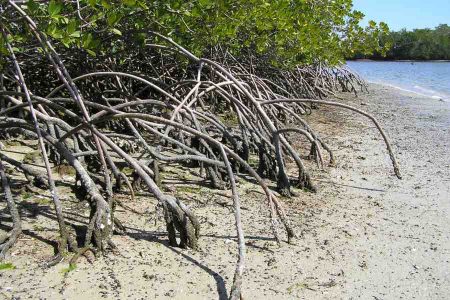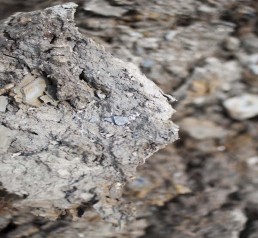Earth scientists have growing interest in clay, Javier Cuadros
Javier Cuadros, Clay Mineralogy Researcher, is one of Clayground’s advisers. He sends news of exciting developments in the world of clay. The latest is a piece about the environmentally beneficial interaction of clays and mangroves. Thank you to Javier.

Mangrove forests are ecosystems found on tropical coasts all around the world. They develop in river estuaries, where some physical obstacle causes water currents to slow down and sediment from the river to deposit very quickly. The sediments produce an island inundated at high tide lying at the frontier between the continent and the sea. A rich ecosystem develops, ranging from micro-organisms to higher animals and plants. Trees called mangroves flourish, hence the name of these habitats. The trees have developed an ability to survive in highly saline conditions. Mangrove ecosystems are important biologically, protect and stabilize the coast from erosion, high tides and hurricanes, and they provide sustenance to local communities.
The connection with clay is the sediments forming the soil for the mangroves are clay-rich. Javier Cuadros is studying these clays with colleagues from the University of Sao Paulo, Piracicaba, in Brazil. Typically the main clay component in the sediment of mangroves is kaolinite with abundant iron oxide. These two components are found together in the tropical continental soils washed into the rivers and transported to the coast. When they reach the mangrove however, all the conditions change abruptly: there is a lot of decaying organic matter in the soil and the salinity is high. In these conditions, the iron oxide dissolves and becomes extremely reactive with the kaolinite. Immediately, a sequence of reactions takes place in which kaolinite is transformed into other clay minerals containing substantial amounts of iron and potassium.
Clay reactions elsewhere on earth are very very slow, taking hundreds of thousands to millions of years, whereas the reaction in the mangroves is much quicker, taking only thousands of years. It may seem a long time but, from the geological point of view, this is a wink. There is another important point to note. On the surface of the earth, clay reactions go in the “opposite” direction, that is, kaolinite is one of the end products. In mangroves the reaction goes backwards to “reconstitute” more complex clays, clays that typically form in very different environments, deep in the Earth. In the reconstitution of complex clays, the mangroves are consuming significant amounts of potassium entering the sea due to mineral dissolution in the continents. So mangrove forests are a very fast clay mineral reactor helping to maintain equilibrium between types of clay and the total amount of potassium in the oceans.
Mangrove forests are attracting increasing attention from Earth scientists as their processes and far-reaching effects come to light. Clay is a central player. However inert clay may look to us, it comes alive in mangrove forests.
-
Pandemic clay action!
18th Aug 21
-
The Volcano and the Microbes: interaction between geology and biology
4th Jun 21
-
Perseverance: a new NASA rover continues to follow Martian clay
2nd Aug 20
-
Research into clay provides clues as to how much water there was on Mars
18th Sep 19
-
22 Hands: British Ceramics Biennial Commission
12th Aug 19
-
Clayground Summer Events
24th Jun 19
-
Colourful Clays on Mars
20th Feb 19
Thames foreshore fragments and visual references
4th Dec 12
How is clay formed? Is it inorganic or organic?
10th Sep 12
CLAY FROM AROUND THE WORLD
3rd Aug 11
Clay Cargo 2014 Collection: the Thames Foreshore
15th Dec 14
Clues to life on Mars likely to be found in clays, Javier Cuadros
5th Aug 16
Clay Cargo 2013-2015
15th Jun 15
Sessions on the Clay Cargo boat, hosted by Fordham Gallery
9th Mar 15
Civic Spaces, Exhibitions
Museums and Galleries, Regeneration
Maker spaces, Rural Sites
Archaeology
Youth and Adult Community Groups, Professionals
Art Groups, Families, Students
Collaborations, Archaeology Sheets
Commissions, Thinking Hands? Research
Knowledge Exchange






